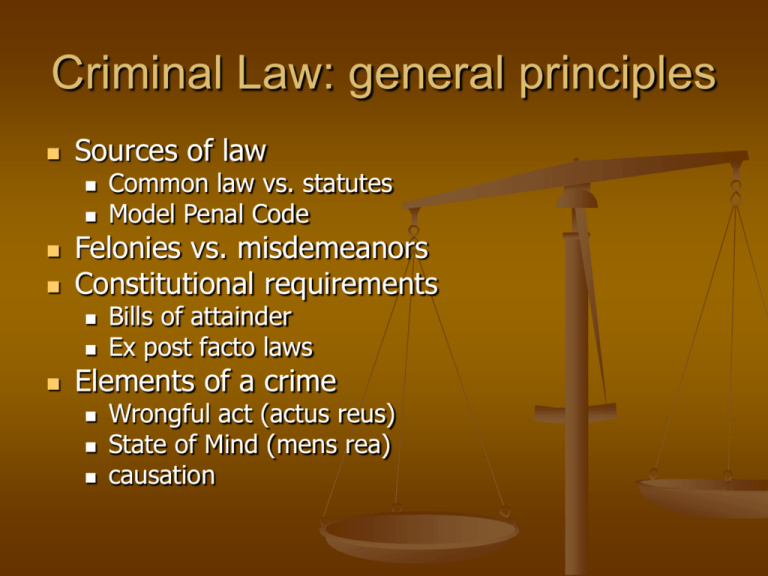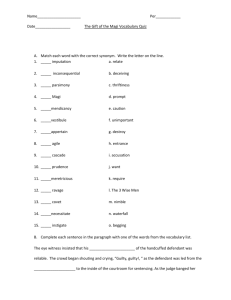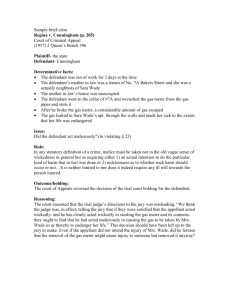Criminal Law: general principles
advertisement

Criminal Law: general principles Sources of law Felonies vs. misdemeanors Constitutional requirements Common law vs. statutes Model Penal Code Bills of attainder Ex post facto laws Elements of a crime Wrongful act (actus reus) State of Mind (mens rea) causation 520. Murder With Malice Aforethought The defendant is charged [in Count ] with murder. To prove that the defendant is guilty of this crime, the People must prove that: 1. The defendant committed an act that caused the death of (another person/ [or] a fetus); [AND] 2. When the defendant acted, (he/she) had a state of mind called malice aforethought(;/.) [AND 3. (He/She) killed without lawful (excuse/[or] justification).] Malice Aforethought There are two kinds of malice aforethought, express malice and implied malice. Proof of either is sufficient to establish the state of mind required for murder. The defendant acted with express malice if (he/she) unlawfully intended to kill. The defendant acted with implied malice if: 1. (He/She) intentionally committed an act; 2. The natural consequences of the act were dangerous to human life; 3. At the time (he/she) acted, (he/she) knew (his/her) act was dangerous to human life; AND 4. (He/She) deliberately acted with conscious disregard for (human/ [or] fetal) life. Murder: Degrees The defendant is guilty of first degree murder if the People have proved that (he/she) acted willfully, deliberately, and with premeditation. The defendant acted willfully if (he/she) intended to kill. The defendant acted deliberately if (he/she) carefully weighed the considerations for and against (his/her) choice and, knowing the consequences, decided to kill. The defendant acted with premeditation if (he/she) decided to kill before committing the act that caused death. 570. Voluntary Manslaughter: Heat of Passion A killing that would otherwise be murder is reduced to voluntary manslaughter if the defendant killed someone because of a sudden quarrel or in the heat of passion. The defendant killed someone because of a sudden quarrel or in the heat of passion if: 1. The defendant was provoked; 2. As a result of the provocation, the defendant acted rashly and under the influence of intense emotion that obscured (his/her) reasoning or judgment; AND 3. The provocation would have caused a person of average disposition to act rashly and without due deliberation, that is, from passion rather than from judgment. 1700. Burglary The defendant is charged [in Count ] with burglary. To prove that the defendant is guilty of this crime, the People must prove that: 1. The defendant entered (a/an) (building/room within a building/locked vehicle/ <insert other statutory target>); AND 2. When (he/she) entered (a/an) (building/room within the building/locked vehicle/ <insert other statutory target>), (he/she) intended to commit (theft/ [or] <insert one or more felonies>). 1800. Theft by Larceny The defendant is charged [in Count ] with [grand/petty] theft [by larceny]. To prove that the defendant is guilty of this crime, the People must prove that: 1. The defendant took possession of property owned by someone else; 2. The defendant took the property without the owner’s consent; 3. When the defendant took the property (he/she) intended to deprive the owner of it permanently…; AND 4. The defendant moved the property, even a small distance, and kept it for any period of time, however brief. 1000. Rape or Spousal Rape by Force, Fear, or Threats The defendant is charged [in Count ] with rape [of his wife] by force. To prove that the defendant is guilty of this crime, the People must prove that: 1. The defendant had sexual intercourse with a woman; 2. He and the woman were (not married/married) to each other at the time of the intercourse; 3. The woman did not consent to the intercourse; AND 4. The defendant accomplished the intercourse by <Alternative 4A—force or fear> [force, violence, duress, menace, or fear of immediate and unlawful bodily injury to the woman or to someone else.] <Alternative 4B—future threats of bodily harm> [omitted] <Alternative 4C—threat of official action> [threatening to use the authority of a public office to incarcerate, arrest, or deport someone. …] 505. Justifiable Homicide: Self-Defense or Defense of Another The defendant is not guilty of (murder/ [or] manslaughter/ attempted murder/ [or] attempted voluntary manslaughter) if (he/ she) was justified in (killing/attempting to kill) someone in (self-defense/ [or] defense of another). The defendant acted in lawful (self-defense/ [or] defense of another) if: 1. The defendant reasonably believed that (he/she/ [or] someone else) was in imminent danger of being killed or suffering great bodily injury; 2. The defendant reasonably believed that the immediate use of deadly force was necessary to defend against that danger; AND 3. The defendant used no more force than was reasonably necessary to defend against that danger. 3450. Insanity: Determination, Effect of Verdict You have found the defendant guilty of <insert crime[s]>. Now you must decide whether (he/she) was legally insane when (he/she) committed the crime[s]. The defendant must prove that it is more likely than not that (he/she) was legally insane when (he/she) committed the crime[s]. The defendant was legally insane if: 1. When (he/she) committed the crime[s], (he/she) had a mental disease or defect; AND 2. Because of that disease or defect, (he/she) did not know or understand the nature and quality of (his/her) act or did not know or understand that (his/her) act was morally or legally wrong. Accessorial Crimes Aiding and abetting Accessories before the fact Accomplices Solicitation Conspiracy Corporate crimes The death penalty Held unconstitutional in 1966 Allowed again, with proper guidelines, in 1976 reinstated in 38 states Jury must “weigh” aggravating versus mitigating circumstances Current controversies Possibly innocent defendants (Illinois) Whether electrocution and lethal injection are “cruel and unusual”






